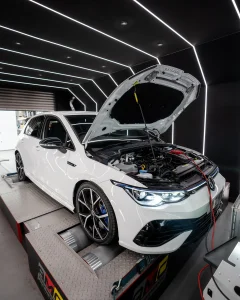A turbocharger, often referred to simply as a “turbo,” is a critical component in modern automotive engineering, designed to enhance the performance and efficiency of internal combustion engines. This device acts as an air pump, utilising the engine’s exhaust gases to drive a turbine, which in turn compresses the intake air, allowing more air to enter the engine’s cylinders. This process increases the engine’s power output without the need to increase its size, offering a blend of performance and efficiency that has made turbochargers a popular choice in both performance and everyday vehicles.
How Does a Turbocharger Work with Exhaust Gases?
At its core, a turbocharger consists of two main components: the turbine and the compressor. These components are connected by a shaft. Here’s a breakdown of the process:
- Turbine Side: Exhaust gases from the engine are directed into the turbocharger, where they pass over the turbine wheel. The energy from these gases spins the turbine at incredibly high speeds—often between 80,000 and 200,000 rotations per minute (rpm). This spinning motion is transferred via the shaft to the compressor.
- Compressor Side: The compressor wheel, driven by the turbine, draws in ambient air and compresses it. This compression increases the air pressure before it enters the engine. This compressed air is then fed into the engine’s intake manifold, increasing the amount of air available for combustion. Boost pressure is monitored by the wastegate to prevent excessive turbine speeds. The compressed air enters the combustion chamber, enhancing the burning of fuel. More air allows for more fuel to be burned, resulting in increased power output from the engine.
Components of a Turbocharger: Turbine Wheel
A turbocharger is a complex assembly with several key components:
- Turbine: Typically a radial turbine design, it is responsible for harnessing the energy from exhaust gases. The exhaust manifold connects to the turbocharger, directing exhaust gases from the engine’s cylinders to spin the turbine.
- Compressor: Usually a centrifugal compressor, compresses the intake air.
- Center Housing Hub Rotating Assembly (CHRA): This houses the shaft connecting the turbine and compressor, allowing them to spin at high speeds with minimal friction. Some CHRAs are water-cooled to protect the turbocharger’s lubricating oil from overheating.
Types of Turbochargers
- Variable-Geometry Turbochargers (VGT): These turbochargers can adjust the flow of exhaust gases to the turbine, optimising performance across a range of engine speeds. This reduces turbo lag and improves efficiency.
- Electrically-Assisted Turbochargers: These combine a traditional exhaust-driven turbine with an electric motor to reduce turbo lag, providing immediate power boost.
Advantages of Turbochargers: Fuel Economy
Turbochargers offer several benefits that make them an attractive option for both manufacturers and consumers:
- Increased Power: Turbochargers allow smaller engines to produce power comparable to larger engines, making them ideal for performance applications. By compressing intake air, turbochargers enable engines to burn more air and fuel, resulting in significantly more power.
- Improved Fuel Efficiency: By recovering energy from exhaust gases, turbochargers improve the overall efficiency of the engine, often resulting in better fuel economy. Turbochargers increase air density compared to atmospheric pressure, leading to better combustion.
- Environmental Benefits: Turbocharged engines can burn fuel more completely, reducing emissions and making them more environmentally friendly.
Disadvantages of Turbochargers: Turbo Lag
Despite their advantages, turbochargers also have some drawbacks:
- Turbo Lag: This is the delay between pressing the accelerator and the turbocharger providing boost. It occurs because the turbo needs time to spool up to speed.
- Complexity and Maintenance: Turbochargers add mechanical complexity to an engine, potentially increasing maintenance requirements and the likelihood of mechanical issues.
- Heat Management: Turbochargers can generate significant heat, requiring additional cooling systems to manage engine temperatures effectively.
Turbochargers vs. Superchargers
While both turbochargers and superchargers are forced induction systems designed to increase engine power, they operate differently:
Turbocharger
- Driven by exhaust gases
- More efficient, as it uses wasted energy
- May experience turbo lag
- More complex, with additional components
Supercharger
- Driven by the engine’s crankshaft
- Less efficient, as it draws power from the engine
- No lag, as it is directly driven
- Generally simpler
Applications of Turbochargers
Turbochargers are used in a variety of applications beyond just passenger vehicles:
- Commercial Vehicles: Trucks and buses often use turbochargers to improve fuel efficiency and power output. Turbochargers also enhance the performance of diesel engines by significantly increasing torque at low RPMs, making them feel more powerful during acceleration.
- Marine Engines: Ships use turbochargers to enhance engine performance and reduce fuel consumption.
- Aviation: Some aircraft engines use turbochargers to maintain power at high altitudes where air density is lower.
Conclusion
Turbochargers represent a significant advancement in engine technology, offering a way to enhance power and efficiency without increasing engine size. By recovering energy from exhaust gases, turbochargers provide a “free” power boost, making them a popular choice in a wide range of vehicles. However, their complexity and potential for increased maintenance must be considered. As technology advances, turbochargers continue to evolve, offering even greater benefits and becoming an integral part of modern automotive engineering.



